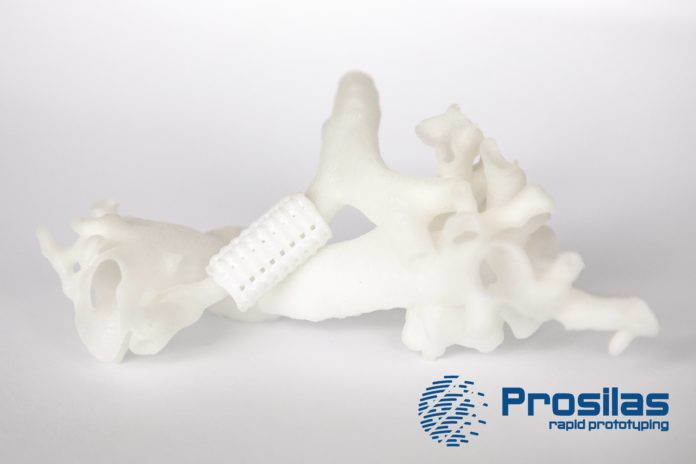
Bronchomalacia is caused by abnormalities in the bronchial cartilage that lead to collapse of the affected airway during respiration. A five-year old child that suffered from this disease recently received the implantation of a 3D printed biocompatible and resorbable stent.
This operation is the result of a collaboration between Prosilas and the medical specialists that were in charge of the kid. If you are a regular reader of 3D ADEPT Media, you will know that Prosilas is an acknowledged 3D printing service based in Italy. The company mostly leverage EOS AM technology in its activities and provides its services to a range of sectors including the toy industry and the medical area.
The use of additive manufacturing to produce medical components is always a tough challenge for specialists of the industry as parts that are directly in contact with the body or vital parts require extreme caution.
To produce a stent that was implanted in this child, Prosilas worked on the development of a new material.
“In 2017 we received the first request for the realization of a polycaprolactone stent by a researcher of the hospital – Bambino Gesù – in Rome. Until that moment we had never heard of Polycaprolactone. Believing in the project, we decided to invest in research and development by working on the properties of the material and by buying a new Selective Laser Sintering system which was entirely dedicated to the project” explains Vanna Menco, CEO of Prosilas.
The 3D printed biocompatible and resorbable stent
The manufacturing of the part requires the combination of new materials including hydroxyapatite and polycaprolactone (PCL). The latter is a biocompatible and bioabsorbable polyester that remains in vivo for 2-3 years before resorption.
The Innovation and Clinical Paths Unit of the hospital created the 2D images (CAT) that were used for the production of the stent.
Prosilas’ operators used a Bioprinting technology/ 4D Printing, in addition to 3D printing, to enable a perfect transformation of materials during the production process.
Further information has not been given on the transformational process and the move from 3D to 4D printing. However, the experience was so stimulating that Vanna Menco is willing to work on projects of this level in the future.
It’s already been a month and a half that the surgery has been performed on the child and so far, everything seems to work perfectly for him.
You can now post free of charge job opportunities in the AM Industry on 3D ADEPT Media.
For further information about 3D Printing, follow us on our social networks and subscribe to our newsletter : Facebook, Twitter, LinkedIn & Instagram !
Would you like to be featured in the next issue of our digital magazine? Send us an email at contact@3dadept.com
The 3D printed biocompatible and resorbable stent
The manufacturing of the part requires the combination of new materials including hydroxyapatite and polycaprolactone (PCL). The latter is a biocompatible and bioabsorbable polyester that remains in vivo for 2-3 years before resorption.
The Innovation and Clinical Paths Unit of the hospital created the 2D images (CAT) that were used for the production of the stent.
Prosilas’ operators used a Bioprinting technology/ 4D Printing, in addition to 3D printing, to enable a perfect transformation of materials during the production process.
Further information has not been given on the transformational process and the move from 3D to 4D printing. However, the experience was so stimulating that Vanna Menco is willing to work on projects of this level in the future.
It’s already been a month and a half that the surgery has been performed on the child and so far, everything seems to work perfectly for him.
You can now post free of charge job opportunities in the AM Industry on 3D ADEPT Media.
For further information about 3D Printing, follow us on our social networks and subscribe to our newsletter : Facebook, Twitter, LinkedIn & Instagram !
Would you like to be featured in the next issue of our digital magazine? Send us an email at contact@3dadept.com






